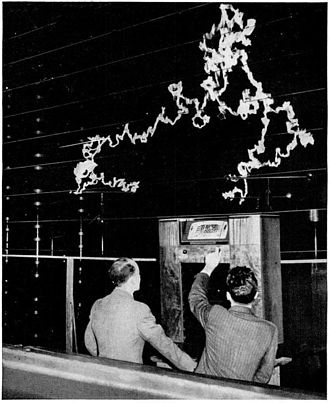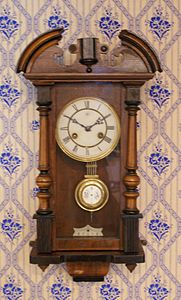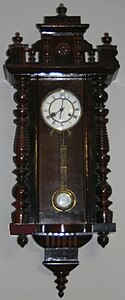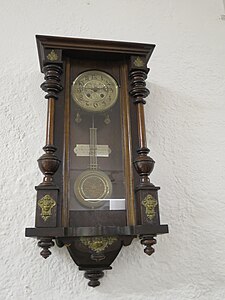User:Chetvorno/work2
Clock analogy
[edit]A mechanism which functions analogously to a feedback oscillator is a mechanical clock, such as a pendulum clock.[1] A pendulum clock is powered by a steady force produced by a hanging weight or a mainspring, however the steady force produces a sinusoidal back and forth motion using a mechanical harmonic oscillator, the pendulum, which keeps time for the clock. Similarly an LC electronic oscillator is powered by a steady DC voltage, but produces an oscillating sinusoidal output voltage using an electrical harmonic oscillator, a tuned circuit. In both devices the frequency of the output is determined by the resonant frequency of the harmonic oscillator.
In a clock the pendulum is kept swinging by a mechanical linkage called an escapement, which gives the pendulum a push each cycle to replace the energy lost to friction. In an electronic oscillator the tuned circuit is kept oscillating by an amplifier, such as a transistor or op-amp, which gives the tuned circuit a pulse of current each cycle to replace the energy lost to the resistance of the circuit. In both devices the impulses must be applied to the harmonic oscillator at the right time in its cycle, the correct phase, so that the driving force reinforces the oscillation, rather than opposing it. This is called positive feedback.
References
[edit]- ^ Hagen, Jon B. (2009). Radio-Frequency Electronics: Circuits and Applications, 2nd Ed. Cambridge University Press. pp. 121–122. ISBN 9781139479073.
Cerda "Understanding quartz crystals and oscillators"
Mathematical theory of resonance
[edit]- Although nonlinear systems also exhibit resonance-like behavior, true resonance as discussed above is a characteristic of linear physical systems, that is physics systems that obey linear differential equations.
- The simplest systems that exhibit oscillatory response and thus resonance are those governed by second order differential equations. Such a system that has one degree of freedom is called a harmonic oscillator. Examples of harmonic oscillators are pendulums, a mass on a spring, and electrical tuned circuits. A harmonic oscillator will have a single resonant frequency. In order to oscillate it must be underdamped.
- The reason for the ubiquitous occurrence of resonance in nature is that any particle, object or system in stable equilibrium in a force field or potential acts linearly in the limit of small amplitude perturbations from equilibrium, with the force acting as a linear restoring force proportional to the distance from the equilibrium point. Therefore such a system can act like a harmonic oscillator.
- More complex systems act like coupled harmonic oscillators. The number of resonant frequencies is equal to the number of independent degrees of freedom. These can be analyzed by linear systems of differential equations. The response of coupled systems to forcing functions is determined by their eigenvalues. Each eigenvalue has an associated eigenfunction which describes a normal mode of motion.
- The eigenfunctions are either real or complex conjugates. Complex conjugate eigenvalues correspond to sinusoidal eigenfunctions, and are the resonant frequencies of the system. Real eigenvalues correspond to exponential (nonoscillatory) motions.
- For constant coefficient differential equations, the eigenfunctions are sinusoids.
- Partial differential equations: the wave equation. Infinite numbers of eigenvalues
Although nonlinear systems also exhibit oscillations and resonance-like behavior, the mathematical theory of resonance strictly speaking applies only to linear time invariant systems, that is physics systems governed by linear differential equations with constant coefficients.
The simplest systems that exhibit oscillations and resonance are those governed by second order differential equations. Such a system that has one degree of freedom is called a harmonic oscillator, and has equation:
=
Flip-flops
[edit]In electronics, the flip-flop or bistable multivibrator is an example of one of the simplest devices that is susceptible to metastability. It has an output that can be in one of two well-defined stable equilibrium states, a high logic level or a low logic level, traditionally designated 1 and 0. Once the output has converged to one of the stable states it will stay there until it is switched by the inputs, so the device is capable of storing one bit of binary information. But under certain conditions it can hover temporarily at an intermediate value between them.
The state space of the output voltage has two stable equilibrium points, at the high and low logic levels. However, between the two stable points, due to considerations of continuity, there is inevitably a point of unstable equilibrium. If the operating point of the device is left near this point by some combination of the inputs, it can stay in this intermediate state indefinitely. This condition is known as metastability. Eventually the output will settle to one of the two stable states. However, since digital logic circuits require their inputs to be close to one of the two logic levels, and the metastable state is in the undefined region between the limits of the logic levels, while it is in this metastable state the behavior of any logic circuits attached to the output will be undefined; they may oscillate or be sensitive to noise, switching unpredictably.
Arbitrators
[edit]An arbitrater is a circuit to decide unambiguously, without creating metastable states, which of two logic signals came first. Many electrical engineers believed that it is possible to build an arbitrator circuit that does not have metastable states. A typical example often suggested is to build a circuit to detect if the input is changing within the setup-hold time of the flip-flop, and if it is, just choose the output arbitrarily - for example always make the output a 1. However, this circuit does not in fact eliminate metastable states, it has its own metastable states at the boundaries of the arbitrary choice region. It is now recognised that whenever the state of a bistable memory element is a function of a continuous variable, such as the timing of an input transition with respect to a clock transition, metastable states exist at the boundary between the regions of the variable resulting in different outpust states.
The most common cause of metastability is violating the flip-flop's setup and hold times. During the time from the setup to the hold time, the input of the flip-flop should remain stable; a change in the input in that time will have a probability of setting the flip-flop to a metastable state.
In a typical scenario where data travels from the output of a source flip-flop to the input of target flip-flop, metastability is caused by either:
- the target clock having a different frequency than the source flip-flop, in which case the setup and hold time of the target flip-flop will be violated eventually, or
- the target and source clock having the same frequency, but a phase alignment that causes the data to arrive at the target flip-flop during its setup and hold time. This can be caused by fixed overhead or variations in logic delay times on the worst case path between the two flip flops, variations in clock arrival times (clock skew), or other causes.[1][2]
- ^ Interfacing Two Clock Domains, Asic World
- ^ Chuck BenzFifos and Ring Buffers
For Radio receiver
[edit]How receivers work
[edit]Frequency synthesizer
[edit]

The frequency received by a superheterodyne receiver, , is determined by the frequency of its local oscillator ; the oscillator frequency is varied to tune the receiver to different stations. Older superheterodyne receivers, as well as some modern ones, use local oscillators whose frequency is controlled by a resonant circuit (tank circut, LC circuit) consisting of a capacitor and inductor connected together. The radio is tuned to different frequencies by turning a knob which varies the capacitance of the capacitor. However, the stability of the receiver's passband frequency is dependent on the oscillator's tuned circuit. The resonant frequency of a tuned circuit is not very stable; variations in temperature can cause frequency drift, causing the receiver to drift off the station frequency. Before crystal control, receivers had a frequency stability of only about 0.1%.[1]
Therefore most modern receivers use a frequency synthesizer which generates the local oscillator frequency from a crystal oscillator. A crystal oscillator, whose frequency is controlled by a quartz crystal, is much more stable than an LC oscillator and has adequate stability to keep the receiver at the transmitter frequency. However the resonant frequency of a crystal is fixed by its physical dimensions; it cannot be varied to tune the receiver to different frequencies. Therefore a digital circuit called a "frequency synthesizer" is used, which can generate multiple frequencies from a fixed "reference frequency" produced by a master crystal oscillator.[2] The new "synthesized" frequencies have the frequency stability of the crystal oscillator, since they were derived from it. In transceivers, the synthesizer usually also generates the carrier frequency for the transmitter.
A disadvantage of synthesizers is that they can only generate a finite number of discrete frequencies; their output cannot be tuned continuously over a band of frequencies the way a variable oscillator can. Therefore they can only cover the received band in a series of small frequency steps. The output frequency of the synthesizer is controlled digitally. This makes possible sophisticated tuning options found in modern receivers: storing of favorite stations, last channel return, and scanning options found in scanner receivers.
A common design for the frequency synthesizer is a phase locked loop (PLL). See lower diagram. The PLL is the loop consisting of the phase comparator, filter, VCO, and programmable counter. The output of the PLL is a frequency which is an integer multiple n of the frequency applied to the phase comparator. The multiplier n is specified by a "frequency control word", which is provided by digital logic, allowing the frequency to be entered by a keypad or controlled by a computer. The output frequency of the synthesizer is
so the frequency received by the receiver is
Increasing n by one causes the frequency output to increase by and thus the received frequency to increase by the same amount. Thus incrementing n causes the receiver to scan up the band in steps of . The fixed modulo-m divider between the master oscillator and the phase comparator reduces the size of the frequency steps.
Digital receivers
[edit]Receiver specifications
[edit]- Bandwidth
- Selectivity
- Sensitivity
- Tuning range
- Distortion
- Output power
History
[edit]Vacuum tube era
[edit]FM reception
[edit]
Frequency modulation (FM) was
Radio communication
[edit]Most radio receivers are part of a radio communication system, which uses radio waves to convey an information-bearing signal across space from one point to another.
- The information to be transmitted is converted by a transducer device into a time-varying electric current, this current is called the modulation signal. For example,
- To transmit sound (audio), a microphone converts the sound waves into a varying electric current, called an audio signal.
- To transmit moving pictures (television), a video camera converts light waves into an electric signal representing a sequence of still images, called a video signal.
- The modulation signal is applied to a transmitter. In the transmitter an electronic oscillator produces a rapidly varying electric current. This is called the carrier wave, because it serves to carry the information through the air to the receiver. The modulation signal is encoded on the carrier in a circuit called a modulator, by varying some aspect of the carrier wave:
- In an amplitude modulation (AM) transmitter, the amplitude (strength) of the carrier is varied.
- In a frequency modulation (FM) transmitter, the frequency (rate of oscillation) of the carrier is varied.
- The radio current from the transmitter is applied to an antenna, which radiates the energy from the transmitter into the air as radio waves (electromagnetic waves). The radio waves convey the information across space to the receiver's location.
- At the receiver the radio waves strike a receiving antenna. The energy from the waves causes tiny currents in the antenna, similar to the currents in the transmitting antenna but much weaker.
- The currents from the antenna are applied to the radio receiver. In the receiver, the tiny radio currents are amplified so they are stronger, and the modulation signal is recovered from the carrier wave by a circuit called a demodulator (detector).
- The output modulation signal from the receiver is applied to a transducer which converts it back to its original form. For example in an AM or FM receiver, the audio output current is applied to a loudspeaker or earphones, which convert it back to sound waves. In a television receiver the video signal is applied to a display screen, which converts it to a moving image.
In addition to radio communication systems, radio receivers are used in radiolocation systems to locate objects, such as radar sets which receive radio waves bounced off aircraft, vehicles, and ships, to locate them, and wildlife tracking They are also used to receive naturally-produced radio waves for scientific research, in radio telescopes.
FM stereo
[edit]Squelch
[edit]A more severe gain control problem occurs in two way radios used for voice communication. With half-duplex radios multiple users share a single radio channel, taking turns transmitting. Transmissions by users are intermittent, separated by periods of no signal. But the radio channel must be monitored constantly by users' receivers. So during operating periods when no unit is transmitting there is no signal for the receiver to receive. The AGC system, unable to distinguish signal from noise, interprets radio noise on the channel as signal, and increases the gain of the receiver until the noise is received as a roar of static in the speaker.
References
[edit]- ^ Stephens, Donald R. (2012). Phase-Locked Loops for Wireless Communications: Digital and Analog Implementation. Springer Science and Business Media. p. 4. ISBN 1461557178.
- ^ Carr, Joseph J. (2001). The Technician's Radio Receiver Handbook: Wireless and Telecommunication Technology. Newnes. pp. 109, 143. ISBN 0750673192.
simplex[1][2][3][4][5][6][7][8][9][10][11][12][13][14]
A cell site, cell tower, or cellular base station is an automated radio transceiver facility and antenna, typically mounted on a tower or pole, that communicates by radio with local cell phones, connecting them to the telephone network.
For Gridiron pendulum
[edit]Pictures of gridiron pendulums I've found
Pictures of mercury regulators:










- ^ "Simplex" The IEEE Authoritative Dictionary of Standard Terms, 7th Ed., 2000, Inst. of Electrical and Electronic Engineers, p.1053
- ^ Weik, Martin (1997). Fiber Optics Standard Dictionary, 3rd Ed. Springer Science & Business Media. p. 925. ISBN 0412122413.
- ^ Longley, Dennis; Shain, Michael (1985). Macmillan Dictionary of Information Technology, 2nd Ed. Springer. p. 100. ISBN 1349178012.
- ^ Coleman, David D.; Westcott, David A. (2006). CWNA Certified Wireless Network Administrator Study Guide (Exam PW0-100). John Wiley and Sons. p. 198. ISBN 0470099607.
- ^ Dean, Tamara (2009). Network+ Guide to Networks, 5th Ed. Cengage Learning. p. 80. ISBN 1423902459.
- ^ Cowley, John (2012). Communications and Networking: An Introduction, 2nd Ed. Springer Science and Business Media. p. 8. ISBN 1447143566.
- ^ Froehlich, Fritz E.; Kent, Allen (1992). The Froehlich/Kent Encyclopedia of Telecommunications, Volume 5. CRC Press. p. 109. ISBN 082472903X.
- ^ Graves, Michael (2008). Computer Technology Encyclopedia. Cengage Learning. p. 303. ISBN 1111803374.
- ^ The New Encyclopaedia Britannica, 15th Ed. The Encyclopedia Britannica Co. 2005. p. 485. ISBN 1593392362.
- ^ James, Kevin (2000). PC Interfacing and Data Acquisition: Techniques for Measurement, Instrumentation and Control. Newnes. p. 285. ISBN 0080513654.
- ^ Frenzel, Louis (2010). Electronics Explained: The New Systems Approach to Learning Electronics. Elsevier. p. 150. ISBN 0080959253.
- ^ Beaty, H. Wayne; Fink, Donald (2012). Standard Handbook for Electrical Engineers, 16th Ed. McGraw-Hill Professional. p. 6.13. ISBN 0071762329.
- ^ Clarke, Glen E. (2015). CompTIA Network Certification Study Guide, 6th Ed. McGraw-Hill Professional. pp. 99–100. ISBN 0071848878.
- ^ Saigh, Robert A. (1998). The International Dictionary of Data Communications. Global Professional Publishing. p. 189. ISBN 1888998288.



















































